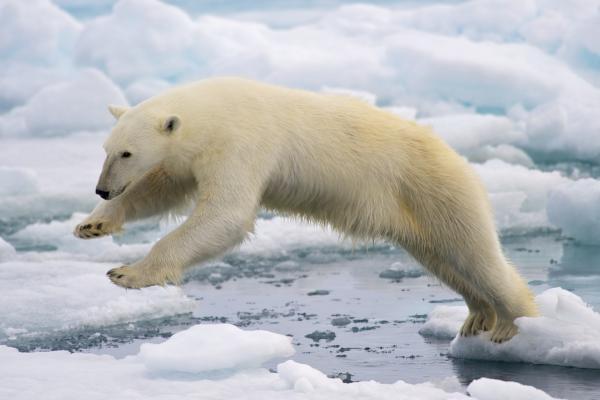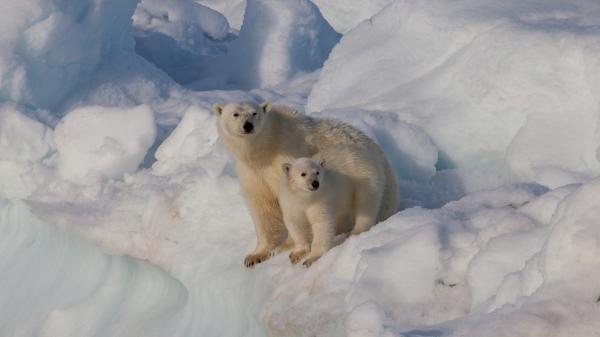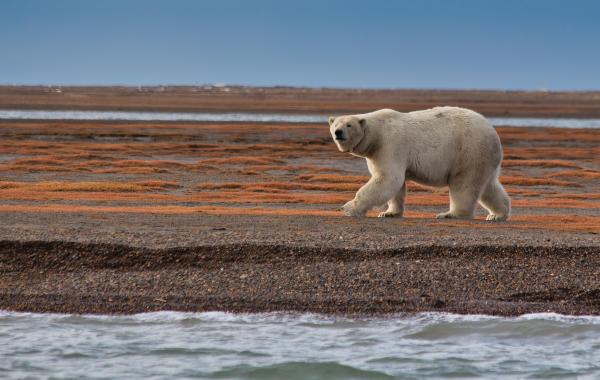
The Arctic habitat of polar bears spans millions of square miles of sea ice and coastal regions across the northern polar region. These powerful hunters live exclusively in the Arctic Circle, moving between ice platforms and coastal areas as they search for seals, their primary prey. These Arctic mammals have developed specialized adaptations to thrive in one of Earth's coldest environments. However, their ice habitat faces unprecedented challenges as rising global temperatures reshape the Arctic landscape.
In the following AnimalWised article, we will discuss polar bears' habitat, its key features, and the challenges they face.
Are polar bears in the north or South Pole?
Polar bears live exclusively in the Northern Hemisphere, specifically throughout the Arctic Circle.
Their range spans five major nations: Canada (which hosts about 60% of the world's polar bears), Greenland, Norway, Russia, and Alaska in the United States. Within Canada, polar bears can be found in Manitoba, Newfoundland, Labrador, Nunavut, Quebec, Yukon, and Ontario. While there have been isolated sightings in Iceland, these are rare occurrences rather than established populations.
According to the International Union for Conservation of Nature (IUCN), polar bears are divided into 19 distinct subpopulations. These groups maintain limited genetic flow and demographic exchange between them.
Exploring the polar bear’s Arctic habitat
The Arctic habitat where polar bears live presents a complex environment that changes dramatically with the seasons.
In winter, sea ice covers much of the Arctic Ocean, creating a vast hunting territory. This ice isn't uniform, on the contrary, it includes different types that polar bears use for various purposes:
- Pack ice: dense, floating ice where seals often create breathing holes.
- Leads: natural breaks in the ice where bears can hunt for seals.
- Pressure ridges: raised ice formations that create shelter for seals and hunting opportunities for bears.
During summer, the ice edge moves northward, forcing bears to adapt their behavior. Some populations follow the ice, traveling hundreds of miles to stay within their hunting grounds. Others move onto land, waiting for the ice to return before they can hunt effectively again.
How are polar bears adapted to live in the Artic?
Polar bears have evolved to live in extreme Arctic conditions, where ocean temperatures range from -50°C in winter to 0°C in summer.
Their insulation system consists of multiple layers working together: a dual-layer fur coat with protective guard hairs and insulating underfur, paired with up to 4 inches of blubber under their skin. The black skin beneath all these layers serves an important purpose because it absorbs and retains heat effectively, keeping the bear warm.
These bears are also built for life in icy waters. Their large paws feature slight webbing between the toes, making them powerful swimmers. Their thick fur also repels water to keep them dry even after long swims. Strong swimming muscles allow them to cover long distances in freezing waters, while specialized vision adaptations help them spot prey even while swimming.
When it comes to hunting, polar bears possess highly specialized features. Their sense of smell is extraordinarily acute and they can detect a seal up to a mile away, even through ice.
Their claws curve slightly, perfect for gripping the slippery ice surface. The rough pads on their paws provide extra traction, preventing slips while stalking prey across frozen surfaces.
What is too hot for a polar bear?
While they can tolerate some warmth, temperatures above 21.1°C (70°F) can cause severe heat stress. This is due to their thick fur, which is designed to keep them warm in freezing temperatures but can trap heat in warmer conditions.
To cool down, polar bears may seek out shade, dig holes in the ground, or immerse themselves in water. However, as climate change causes Arctic temperatures to rise, polar bears are facing increasing challenges from heat stress, which can impact their health and survival.

Why is the Arctic important to polar bears?
Polar bears occupy a crucial position at the top of the Arctic food chain, where their presence indicates a healthy ecosystem. Their primary hunting grounds occur where Arctic waters support large populations of ringed (Pusa hispida) and bearded seals (Erignathus barbatus), their main prey.
These seals depend on sea ice for resting, pupping, and molting, creating a direct link between ice conditions and polar bear hunting success.
The Arctic ecosystem supporting polar bears involves a complex web of life:
- Phytoplankton blooming beneath sea ice
- Fish feeding on the plankton
- Seals eating the fish
- Polar bears hunting the seals
Polar bears rely on this delicate balance within their ecosystem. When this balance is upset, for instance, by reduced sea ice affecting plankton growth, it triggers a chain reaction. This can lead to decreased food availability for seals, a primary prey for polar bears. As a result, polar bears face increased challenges in finding sufficient food to survive and reproduce.
Ever wondered how much a polar bear eats in one day? Our feeding habits guide explains all.
How far do polar bears roam?
Polar bears cover extensive distances throughout their lives, following ice conditions and food availability. Individual bears can travel 32-48 km (20-30 miles) per day when searching for food, and their annual range can exceed 350,000 square km (135,000 square miles).
Bears adjust their movements seasonally:
- Spring: focus on seal hunting during pupping season.
- Summer: follow retreating ice or move to land.
- Fall: move toward denning areas or prime hunting grounds.
- Winter: females den while pregnant; males continue hunting.
Female polar bears build maternity dens in snow banks, often several kilometers inland. They stay in these dens from late fall until spring, giving birth and nursing their cubs. Males continue hunting throughout winter, establishing temporary territories in productive hunting areas.
Think you know polar bears? Test your knowledge with these 20 scientific facts.

How Climate Change Impacts Polar Bears
The Arctic is warming at twice the speed of the global average, fundamentally altering the environment polar bears need to survive. As sea ice melts earlier in spring and forms later in fall, polar bears face longer periods without access to their primary hunting grounds.
When bears can't hunt from sea ice platforms, they must swim longer distances between ice floes, depleting their valuable energy stores. Some bears now swim up to 100 miles to find suitable hunting grounds, an exhausting journey that particularly threatens cubs and younger bears. The added physical stress makes bears more vulnerable to illness and reduces their breeding success.
Food scarcity has pushed many bears to spend more time on land, leading to new challenges. On land, they cannot effectively hunt seals, their primary prey. While bears can eat berries, eggs, and other land-based foods, these alternatives don't provide the high-calorie nutrition they get from seal blubber. As a result, many bears lose significant body mass during these extended periods on shore.
The changes also affect mothers and cubs. Female polar bears traditionally build winter dens in areas with deep snow, where they give birth and nurse their cubs. Rising temperatures can cause these dens to collapse or force females to den in less suitable locations. Cubs born in poor denning conditions face higher mortality rates.
Without significant reductions in greenhouse gas emissions, sea ice will continue to decline, making survival increasingly difficult for polar bears across their Arctic range. The bears' future depends heavily on how quickly and effectively humans address climate change.
Meet the polar bear's Arctic neighbors in our complete guide to northern wildlife.

If you want to read similar articles to Where Do Polar Bears Live?, we recommend you visit our Endangered animals category.
- WWF (2015). Climate change impacts on species . Available at: http://d2ouvy59p0dg6k.cloudfront.net/downloads/species_and_climate_climate_impact_sp_v1.pdf
- Gunderson, A. (2009). Ursus maritimus . Animal Diversity Web. Available at: https://animaldiversity.org/accounts/Ursus_maritimus/
- Wiig, Ø., Amstrup, S., Atwood, T., Laidre, K., Lunn, N., Obbard, M., Regehr, E., and Thiemann, G. (2015). Ursus maritimus . The IUCN Red List of Threatened Species 2015 . Available at: https://dx.doi.org/10.2305/IUCN.UK.2015-4.RLTS.T22823A14871490.en